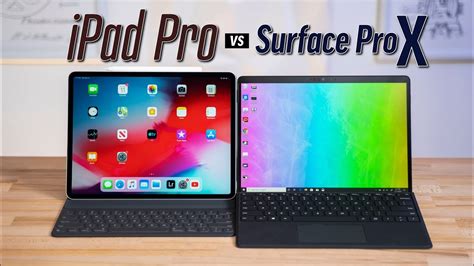In the realm of premium tablets, two titans stand tall: the Apple iPad Pro and the Microsoft Surface. Both devices boast impressive hardware and software capabilities, catering to a wide range of users, from creative professionals to students. But which one reigns supreme?

Key Specifications
To kick off the comparison, let’s dive into the crucial specifications that define these devices:
| Feature | iPad Pro | Microsoft Surface |
|---|---|---|
| Display | Liquid Retina XDR (12.9-inch: 2732 x 2048; 11-inch: 2388 x 1668) | PixelSense Flow (13-inch: 2880 x 1920; 12.3-inch: 2736 x 1824) |
| Processor | Apple M1 | Intel Core i5/i7 or ARM Qualcomm Snapdragon 8cx |
| Storage | 128GB – 1TB | 128GB – 1TB |
| Operating System | iPadOS 14 | Windows 10/Windows 11 |
| Camera | 12MP wide, 10MP ultrawide | 8MP front-facing, 10MP rear-facing |
| Weight | 1.03 lbs (12.9-inch) | 1.74 lbs (13-inch) |
Display and Design
Both the iPad Pro and Surface flaunt stunning displays. The iPad Pro boasts Apple’s Liquid Retina XDR technology, delivering exceptional color accuracy and HDR performance. The Surface, on the other hand, features a slightly larger PixelSense Flow display with a higher refresh rate, resulting in smoother scrolling and gaming experiences.
In terms of design, the iPad Pro exudes sleekness with its slim profile and rounded corners. The Surface, however, offers a more versatile design with a built-in kickstand that allows it to be used in a variety of positions.
Performance
When it comes to performance, the battle between the iPad Pro’s Apple M1 chip and the Surface’s Intel Core processors is a close one. Both devices provide ample power for most tasks, including multitasking, video editing, and gaming. However, the iPad Pro consistently benchmarks slightly higher, indicating a slight edge in performance.
Software
The software experience is a key differentiator between these tablets. The iPad Pro runs on iPadOS, a touch-optimized operating system that emphasizes ease of use and a fluid app ecosystem. The Surface, on the other hand, runs Windows, a desktop-class operating system that offers greater flexibility and support for a wider range of applications.
Battery Life
Battery life is crucial for mobile devices. The iPad Pro delivers exceptional battery life, lasting up to 10 hours on a single charge. The Surface’s battery life is slightly shorter, averaging around 7-8 hours, depending on usage patterns.
Price
Pricing for both devices varies depending on the configuration and storage capacity. In general, the iPad Pro tends to be slightly more expensive than the Surface, especially at higher storage capacities.
Which One Is Right for You?
The choice between the iPad Pro and Microsoft Surface ultimately depends on your specific needs and preferences.
-
If you prioritize touch-based functionality, a user-friendly operating system, and exceptional battery life, the iPad Pro is an excellent choice. It excels in creative applications, multimedia consumption, and general productivity tasks.
-
If you value the flexibility of a desktop-class operating system, the ability to run a wider range of applications, and a versatile design, the Microsoft Surface is the way to go. It’s perfect for work, school, and entertainment, offering a comprehensive experience.
Effective Strategies
-
Identify your needs: Determine what you primarily need a tablet for. Do you require a touch-optimized device for creative work or a more versatile device for work and play?
-
Consider the ecosystem: Apple’s ecosystem offers a seamless experience between devices, while Windows supports a wider range of applications and peripherals.
-
Research the features: Compare the display quality, performance benchmarks, and other features to ensure they meet your specific requirements.
-
Read reviews and compare prices: Seek independent reviews from reputable sources to gain insights into real-world performance and value for money.
Common Mistakes to Avoid
-
Overspending: Don’t purchase a device with more storage or features than you need. Consider your actual usage patterns and choose a model that fits your budget.
-
Ignoring software compatibility: Ensure that the applications you rely on are compatible with the operating system of the device you choose.
-
Not protecting your device: Invest in a protective case or screen protector to safeguard your expensive tablet from damage.
Pros and Cons
iPad Pro
Pros:
- Exceptional display quality
- Powerful performance
- Easy-to-use operating system
- Long battery life
Cons:
- Limited application ecosystem
- Expensive
Microsoft Surface
Pros:
- Versatile design with built-in kickstand
- Wide range of application support
- Supports peripherals like keyboards and mice
- Affordable options available
Cons:
- Shorter battery life
- Windows can be more complex for touch-based use
Conclusion
The iPad Pro and Microsoft Surface stand as premium tablets with unique strengths and weaknesses. The iPad Pro excels in its display, performance, and battery life, making it an ideal choice for creative professionals and entertainment enthusiasts. The Microsoft Surface, on the other hand, offers a more versatile experience with Windows, a wide application ecosystem, and a flexible design, making it a better fit for productivity and multi-purpose use.
